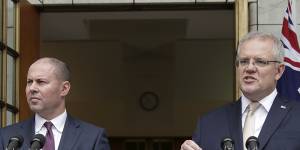
Treasurer Josh Frydenberg and Prime Minister Scott Morrison in Canberra on March 12.Credit:Alex Ellinghausen
How do stimulus packages help the economy?
When the economy is slowing down,it's common to hear about the Reserve Bank of Australia cutting interest rates to try to encourage borrowing and spending. However,monetary policy is just one lever that can be pulled and rates are already at a record low 0.25 per cent.
Loading
Automatic stabilisers,which are mechanisms that help manage fluctuations,also kick in through the ebbs and flows of the economy. These include government benefits and assistance. Improvements in job numbers mean fewer people need income help but as unemployment rises,the opposite is true and more is spent helping these households.
But when the shock is more significant and these stabilisers are not easing the highs and lows,a less commonly used option – fiscal stimulus packages – can be used.
This is where the government directly takes action and spends extra money to give the economy an adrenaline shot. This can come in many different forms,such as cash handouts,grants,infrastructure building programs and tax reductions.
However,the overall aim is the same – to give the economy a big enough boost to get through a difficult period. For instance,providing cash handouts directly to households flows into retail and services,provided recipients of the money go out and spend.
This helps keep people in these industries employed,paying their mortgages and bills and spending on services and goods themselves. So if you're a recipient of the $750,the idea is that you spend it.
Prime Minister Scott Morrison has directly targeted the government's packages to keeping Australians in jobs and to provide a safety net for those who lose work.
The aim of the wage subsidy plan is a little different. Mr Morrison has said the economy will go into"hibernation"while the worst of the pandemic passes. In that context,the $1500 payment is less about boosting the economy than helping Australians pay for essentials while the economy is largely paused.
"We want to keep the engine of our economy running through this crisis,"Mr Morrison said."It may run on idle for a time but it must continue to run."
This kind of spending comes at a very real price. It can cause a budget deficit,where government spending is more than revenue. If too much is spent on stimulus,it can risk years of debt and deficit,but if there isn't enough of a boost in the right areas,the country risks entering into a recession.
The government can borrow to cover any shortfall in domestic demand,and collapsing global interest rates put it in a better position to do this. Getting the balance wrong can be difficult politically but,more crucially,it has a real-life impact on the livelihood of Australians,their jobs and future prosperity.
It's not always clear until years down the track whether the actions being taken are the right ones.
Loading
Has there been a stimulus package like this before?
Yes. In Australia and overseas,governments have brought in stimulus packages to try to avoid a recession or at least reduce the severity of a downturn.
Several countries including the United Kingdom,Canada,Germany and New Zealand have introduced their own wage subsidy plans to address the pandemic's economic effects.
The most comparable and recent example in Australia is the large stimulus package implemented during the global financial crisis by the Rudd government. Aninitial package worth $10.4 billion was unveiled in October 2008,including payments to pensioners,family support payments and first-home-buyer grants,to help lessen economic turbulence.
In February 2009,asecond package worth $42 billion was announced. This included a $26 billion infrastructure program,$12.7 billion in direct payments to households and $2.7 billion for businesses. Within this package,Australians earning under an $80,000 threshold were given $950 and were encouraged to spend to boost the economy.
Kevin Rudd said at the time:"The government will move heaven and earth to reduce the impact of the global recession on Australia."
Will there be more measures in 2020?
State and federal governments are still in negotiations about further measures to help tenants manage their rental payments.
"The government will continue to do all within our power and all within our capacity,"Mr Morrison said at a press conference on March 30 after unveiling the wage subsidy.
And the government is yet to finalise the details of its $130-billion JobKeeper program. Parliament will have to be recalled to pass legislation to put the government's policy into law,with money not set to start flowing until May.
Sign up to our Coronavirus Update newsletter
Get our Coronavirus Update newsletter for the day's crucial developments at a glance,the numbers you need to know and what our readers are saying. Sign up toThe Sydney Morning Herald's newsletterhere andThe Age'shere.
For more information on the federal government's stimulus package,phone 02 6263 3030 (Monday to Friday 8.30am to 5.30pm) or emailTreasuryCOVID-19Coord@TREASURY.GOV.AU